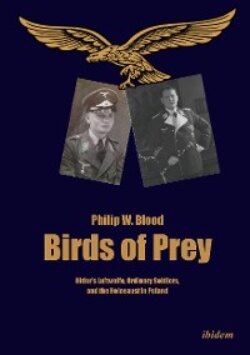Оглавление
Philip W. Blood. Birds of Prey
Acknowledgements
List of Tables
List of Diagrams
List of Maps
List of Images
Abbreviations and Glossary
1942
Excursions in Microhistory
The acquisition of sources
Engaging with microhistory
Terminology
An Aide-Mémoire: Reading Maps Like German soldiers
I. The Nazis and military geography
II. The science of maps
III. The GIS maps
1. The Ogre of Rominten
I. The Green
II. The Blue
III. Raising a social-military order
2. The Conquest of Wilderness
I. War
II. The Battle for Białowieźa (22–30 June 1941)
III. The Green in the ascendancy
IV. A cultural synopsis of genocide
3. Grossdeutschland
I. Prussian administration
II. The Białowieźa arena
III. The hunt
4. Bandenbekämpfung in the ‘Home Forces Area’
I. Rude arrival
II. Turf war
III. Manpower fluctuations
IV. The bureaucracy of Bandenbekämpfung
5. The Białowieźa Partisans
I. Surveillance, counterintelligence and luck
II. The Trusty
III. A view from within
IV. Countering the bands
6. Population Engineering
I. Accounting for wilderness
II. The curious case of Roczkowka
III. Making wilderness
IV. Reprisals and revenge
7. Judenjagd
I. In step with the Jagdkommando
II. Hunting Jews
8. German Soldiers and Bandenbekämpfung
I. Herbst and Bandenbekämpfung
II. NCOs: command spine in the field
III. Military dogma, military order or military efficiency?
9. 1943
I. Post-Stalingrad politics
II. Dissolution
III. Body count politics
10. Göring’s Hunter Killers
I. The chosen man
II. Command and control
III. Technology and security
IV. Stalin’s partisans
11. Bandenjagd
I. Stalking partisans
II. Dubious beaters
III. Death in the forest
IV. The politics of large operations
V. More body counts
12. 1944: Retreat
I. The final phase
II. Vikings, Bears and Panthers
III. Rückkampf: memories of a retreat
Conclusion: Memories of a Never Happened History
I. Memories of Rominten
II. A Białowieźa fantasy
III. The lost Jewish Past
IV. Myth of the clean Luftwaffe
Epilogue
Appendix 1: German Ranks
Appendix 2: Luftwaffe Soldiers
I. Sixth company officers
II. Company men
III. A summary of casualties, 1942–1944
Bibliography. Archival sources. German Archives: Arolsen Archives (AA)
Bundesarchiv (BArch)
Formerly Zentralnachweisstelle, Aachen-Kornelimünster (BA ZNS)
Deutsche Dienststelle (DDst), Berlin
United Kingdom. Imperial War Museum (IWM)
National Archives, formerly the Public Records Office (TNA)
United States of America. National Archives (NARA) of Washington D.C.: College Park, Maryland
Yad Vasham Archive, Jerusalem
I. Official codes, reports, handbooks, manuals, dictionaries
II. Oral sources: interviews, newspapers, television and radio
III. Doctoral theses and open access sources
IV. Books and articles. Articles and books before 1945
Books and articles since 1945
About the Author
Отрывок из книги
ibidem-Press, Stuttgart
Professor E. Richard Holmes (1946–2011)
.....
35 Thomas Kühne, Kameradschaft: Die Soldaten des nationalsozialistischen Krieges und das 20. Jahrhundert, (Göttingen, 2006). See also Kühne, Belonging and Genocide. Hitler’s Community 1918–1945, (New Haven, 2010) and ‘Kameradschaft – “das Beste im Leben des Mannes”, Die deutschen Soldaten des Zweiten Weltkrieges in erfahrungs- und geschlechtergeschichtlicher Perspektive,’ Geschichte und Gesellschaft 22 (1996) S.504–529, and Kühne, The Rise and Fall of Comradeship: Hitler’s Soldiers, Mass Bonding and Mass Violence in the Twentieth Century, (Cambridge, 2017).
36 TNA, WO 208/3608 CSDIC SIR 1329, Establishment of a Jgdko by Secret order of the Befehlshaber Südost, interrogation of UFF’S Kotschy and Boscmeinen, 13 December 1944. WO 208/3979, A Study of German Military Training, Combined Services, May 1946.
.....
